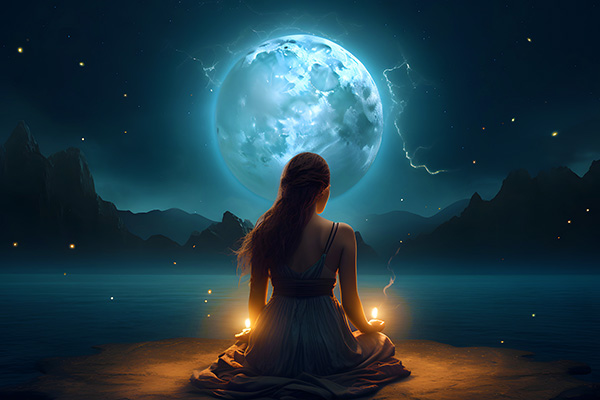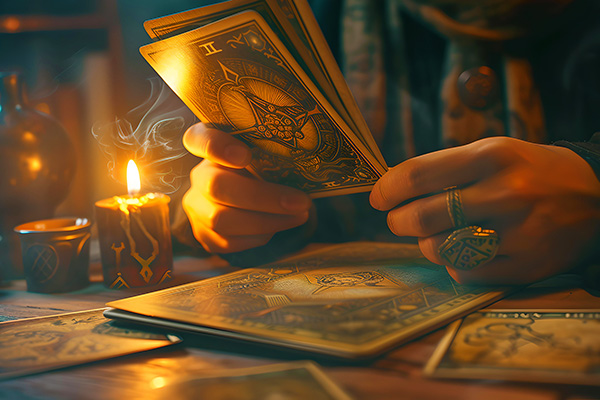mysticism
What I Learned From Egyptian Goddess Hathor
 From the moment I first encountered her, Hathor, the ancient Egyptian goddess, she felt like a luminous companion on my spiritual path.
From the moment I first encountered her, Hathor, the ancient Egyptian goddess, she felt like a luminous companion on my spiritual path.
To me she isn’t just a myth or a symbol. She’s a living presence and a spiritual guide. She’s also a gentle yet powerful presence in my psychic and healing work. Her energy speaks to me on a deeply intuitive level.
My connection with Hathor began unexpectedly while reading a book on ancient Egypt. Suddenly, I felt a comforting warmth surround me. It was as if a long-lost friend had returned.
Then, I was guided to raise my hands, palms facing outward and I sensed her hands and palms facing mine. A glow of golden light flashed before me and I felt a warm sensation entering my palms and almost as though my hands were being supported and held, and all time was suspended.
In that timeless and powerful moment, Hathor’s nurturing love enveloped me, and her ancient wisdom whispered that time is merely a construct.
In the Infinite Light, there is no past or future, only this sacred now. In is in the present moment that healing and miracles unfold.
As a psychic, I find that Hathor naturally aligns with my practice. She is not just the goddess of love and beauty, though she radiates both. She embodies a vibrant, nurturing energy that opens emotional and spiritual channels.
Manifest Your Best Life With The Moon Phases
 Aligning with the moon’s phases is a powerful tool for manifestation, emotional balance, and energetic cleansing. Its ever-changing phases offer varying energy frequencies that can be used to improve many aspects of life.
Aligning with the moon’s phases is a powerful tool for manifestation, emotional balance, and energetic cleansing. Its ever-changing phases offer varying energy frequencies that can be used to improve many aspects of life.
Many ancient traditions revered the moon as a divine feminine force. Honored as a celestial goddess, her light was believed to guide humanity. Her journey across the sky mirrored the universal cycles of life, death, and rebirth that govern everything.
For the Greeks, the moon was Selene, the shining personification of lunar power, radiating purity and grace as she drove her chariot across the night sky. Selene was also linked to Artemis, the fierce goddess of the hunt and wild places. This connection embodied the moon’s untamed nature and its link to the wilderness.
Another important figure was Hecate, the formidable goddess of magic, witchcraft, and crossroads. She represented the moon’s mysterious and powerful aspects, guiding souls through the night. In Indian mythology, Chandra, the moon god, personified beauty and light, bringing calmness and tranquility to the night.
Throughout these ancient traditions, the moon was consistently viewed as a mysterious guide and careful keeper of sacred timing. Her rhythm influences everything from harvests to human emotions.
When we intentionally tune into this ancient, cosmic rhythm, we discover the profound, often subtle ways the continual ebb and flow of lunar energy directly influences our inner being and daily life. Our emotions, energy levels, and thoughts are closely tied to the moon’s gravitational pull and energy shifts.
Holding On To What Never Changes
 Nature always inspires deep thoughts in me. There’s something about pausing to watch the wind rustle through the trees or to see the sun gently filter through the clouds that invites stillness and reflection.
Nature always inspires deep thoughts in me. There’s something about pausing to watch the wind rustle through the trees or to see the sun gently filter through the clouds that invites stillness and reflection.
Today, I found myself contemplating the constantly changing seasons. In the Northern Hemisphere, we are a month away from the summer solstice, and the days are becoming increasingly long and warm with golden light. The trees are lush and full, the air hums with the sound of insects, and gardens overflow with life.
Change is everywhere. It’s evident in the ripening of fruit, the intense afternoon heat, and the subtle shift in the season’s energy toward harvest.
It’s not just nature, either. Our lives are constantly evolving, too. Relationships shift, careers transition, health fluctuates, and dreams reshape themselves over time.
No matter where we turn, we hear messages such as “Change is inevitable,” and “Don’t be afraid of change.”
Yes, change is necessary. As spiritual beings, we are meant to continually grow and evolve. Change challenges us, stretches us, and teaches us.
But let’s be honest — sometimes it’s also deeply unsettling. This is especially true in times like these, when the world feels uncertain, divided, and fragile.
How Mudras Connect Mind, Body and Soul
 Have you ever wondered why some people hold their fingers in unusual positions while meditating?
Have you ever wondered why some people hold their fingers in unusual positions while meditating?
These sacred hand gestures, known as mudras, are not just meant to “look cool” — they are a powerful energetic practice rooted in ancient spiritual traditions. They are intentional postures designed to channel energy, focus the mind, and deepen spiritual connection.
Mudras are an integral part of many spiritual lineages, most notably Kundalini Yoga – an energetic healing science that dates back thousands of years – as well as Hinduism, Buddhism, Jainism, classical Indian dance, and yogic disciplines.
Its origins can be traced back to the Vedas, the oldest sacred texts of Hinduism, where mudras were used in rituals to invoke divine blessings and spiritual power.
Over the centuries, these gestures have evolved into essential tools within yoga, tantra, and meditation practices. Their purpose: to help the practitioner direct subtle energies, sharpen awareness, and align with a higher consciousness.
In Sanskrit, mudra means “seal,” “sign,” or “gesture.” Far from mere physical postures, these gestures connect body, mind, and spirit, forming an energetic circuit that speaks directly to our auric field. Each mudra is a subtle energetic signal – each finger position resonating with specific astrological influences, emotional states, and elemental energies.
While some mudras involve the entire body, most are performed with the hands and fingers. Their effects are both profound and practical, enhancing spiritual practice, supporting healing, and facilitating the flow of life-force energy (prana or chi) through the body.
Honoring Your Divine Purpose In Uncertain Times
 Knowing your purpose and consciously living it in this day and age is one of the greatest blessings one can experience in this lifetime.
Knowing your purpose and consciously living it in this day and age is one of the greatest blessings one can experience in this lifetime.
Yet, in a troubled world of mass distraction, upheaval, fear, and uncertainty, many spiritual seekers struggle with doubt, confusion, or even despair.
Many people feel lost and uncertain these days. It’s part of being human in the digital age and living in very uncertain times – the pain of questioning, the longing to understand why we are here, and what we are meant to do.
But this is not a sign of weakness or failure. In fact, it is an essential part of our spiritual growth and conscious evolution.
For me, my personal definition of “purpose” has evolved over the years, but at its core it remains constant: exploring the spiritual or higher realms, the invisible threads that weave through our existence, the vast mysteries of spirit and the cosmos.
I believe my soul purpose is to venture into the unseen realms to continue my own immortal, infinite path. I am meant to do this not only for myself, but also for the collective.
My mission is to bring back what I learn from these journeys and share it with others, to offer illumination in the dark corners, to reduce chaos, and to help restore balance to the universe. In short, I strive to be a source of hope and enlightenment, a humble guide to all who are willing to receive this wisdom. Continue reading
The Tarot Is A Mystical Bridge To Spiritual Insight
 Mysterious, symbolic and highly energetic, the Tarot is a high vibrational tool that can help us explore the deeper meaning behind the events of our daily lives, and the influence of Spirit in our earthly existence.
Mysterious, symbolic and highly energetic, the Tarot is a high vibrational tool that can help us explore the deeper meaning behind the events of our daily lives, and the influence of Spirit in our earthly existence.
The Tarot especially offers guidance in situations where may feel lost or confused, and it serves as a mystical bridge between our physical reality and the metaphysical realm.
The cards have their own energy, a high vibrational frequency, which Spirit uses to communicate messages of guidance, encouragement, insight and caution.
Every Tarot reader has their own set of spiritual gifts and psychic abilities, and therefore we tend to each develop our own reading style accordingly.
In my own readings, I find that Spirit most often seeks to illuminate areas in our lives where changes and healing may be needed, in order to bring about the most beneficial future outcomes. This can be anything from the need to shift one’s perspective, to the need to let go, or sometimes the need to simply accept things as they are.
Ultimately, I find Spirit uses the Tarot to get us ‘unstuck,’ so we get back in the flow. When we are in the flow, or in alignment, we are creating with the Universe, instead of creating resistance. Only then are we truly moving toward our highest good and the fulfillment of our greatest potential.
The Tarot is a conduit for communication with our guides and our higher self, through which we can gain a deeper understanding of the soul lessons and the magic happening in our lives.
